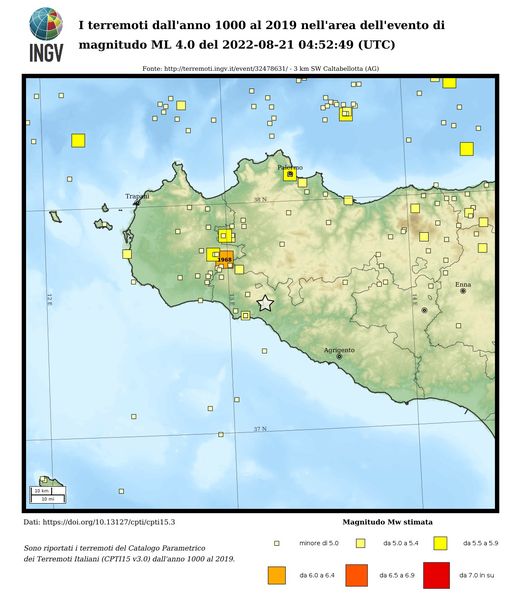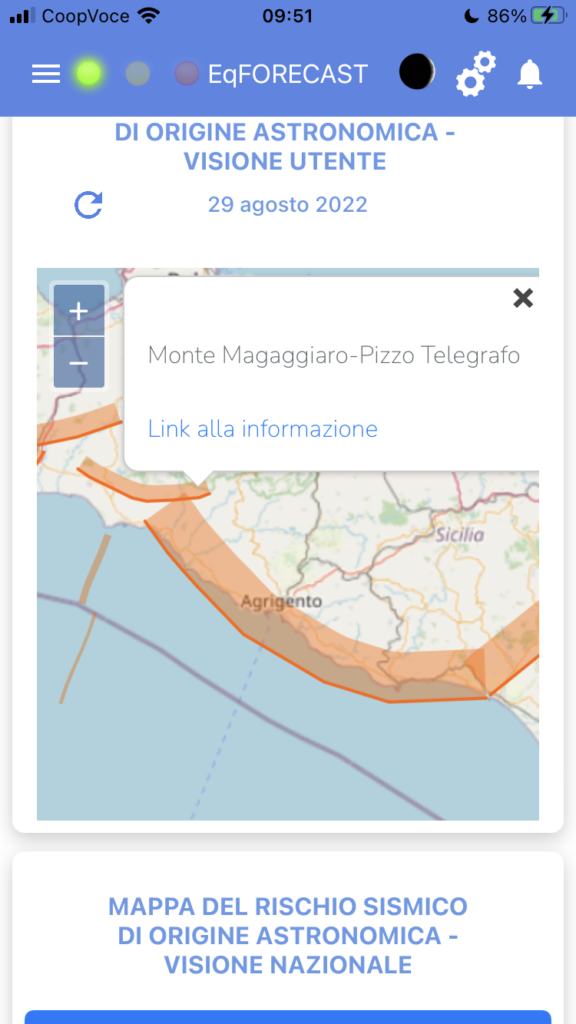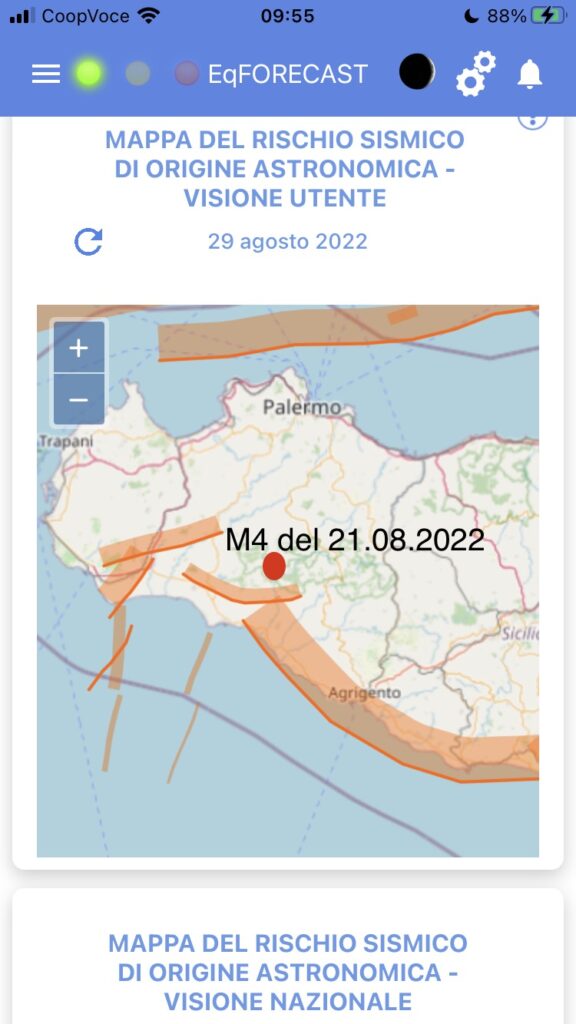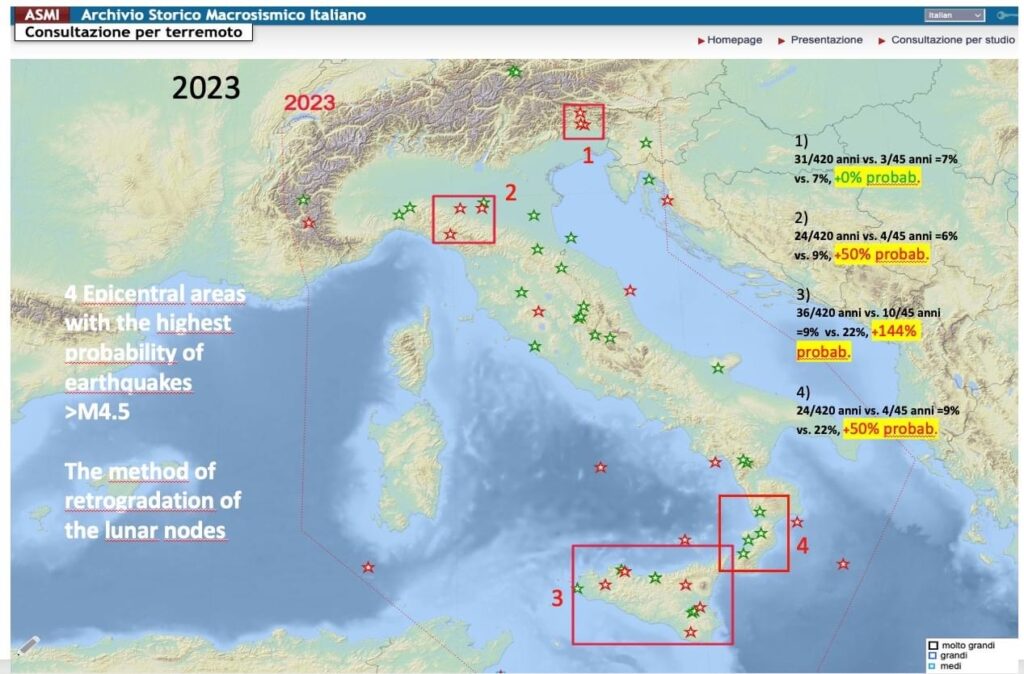
IL TERREMOTO DI MAGNITUDO ML 4.0 DEL 21-08-2022 A GIULIANA (PA) E LE CONDIZIONI ASTRONOMICHE.
THE MAGNITUDE ML 4.0 EARTHQUAKE DATED 08-21-2022 IN GIULIANA (PA) AND ASTRONOMIC CONDITIONS.
IL TERREMOTO DEL BELICE DEL 1968 E LE (SIMILI) CONDIZIONI ASTRONOMICHE DEL 2023.
THE BELICE EARTHQUAKE OF 1968 AND THE (SIMILAR) ASTRONOMIC CONDITIONS OF 2023.
Avrei voluto intavolare una discussione su questo terremoto di M4 definito “strano” dal dott. Alessandro Amato perché caratterizzato dall’assenza di sciami precedenti e seguenti (si veda il post https://m.facebook.com/story.php?story_fbid=1639152703148716&id=100011620057542), ma non mi è stato permesso sulla sua pagina, perché il dott. Amato (geologo INGV) ha preferito attaccarmi personalmente e inspiegabilmente paventando nelle mie spiegazioni un tentativo di truffa.
I would have liked to start a discussion on this M4 earthquake defined as “strange” by dr. Alessandro Amato because characterized by the absence of previous and following swarms (see the post https://m.facebook.com/story.php?story_fbid=1639152703148716&id=100011620057542), but I was not allowed on his page, because dr. Amato (geologist INGV) preferred to attack me personally and inexplicably fearing an attempted scam in my explanations.
Riprovo qui nel nostro gruppo a lanciare la discussione. Il timore è che questo terremoto M4 in Sicilia sia un precursore isolato di un aumento di sismicità prevista dal nostro modello EqForecast per il 2023 per la Regione. Per non c’è particolare certezza, ma cerco di spiegare.
I try again here in our group to launch the discussion. The fear is that this M4 earthquake in Sicily is an isolated precursor to an increase in seismicity predicted by our EqForecast model for 2023 for the region. For there is no particular certainty, but I try to explain.
Partiamo dalla considerazione che il sisma è avvenuto perfettamente nel tempo e magnitudo previsti da 2 settimane dal modello di previsione sismica con il metodo astronomico di cui al seguente post: https://www.facebook.com/groups/EarthquakesForecast/permalink/2335966123227501/.
Let’s start from the consideration that the earthquake occurred perfectly in the time and magnitude predicted for 2 weeks by the seismic prediction model with the astronomical method referred to in the following post: https://www.facebook.com/groups/EarthquakesForecast/permalink/2335966123227501/.
Cioè, voglio dire che dal punto di vista del tempo e della magnitudo questo terremoto si inquadrerebbe bene nel modello che trova una correlazione storica tra le abituali posizioni dei pianeti e appunto la magnitudo ed il tempo di questo sisma.
That is, I want to say that from the point of view of time and magnitude this earthquake would fit well into the model that finds a historical correlation between the usual positions of the planets and precisely the magnitude and time of this earthquake.
Per contro, questa modellizzazione non ci ha fornito riscontro (come per oltre l’80% dei casi invece accade) per il LUOGO del terremoto.
On the other hand, this modeling did not provide us with feedback (as happens in over 80% of cases) for the PLACE of the earthquake.
Il luogo del terremoto è previsto da una nostra mappa on line (a disposizione degli abbonati all’App EqForecast) che restituisce i luoghi dove statisticamente sono avvenuti il maggior numero di terremoti storici nella nostra Penisola, in corrispondenza delle stesse configurazioni astronomiche dei pianeti del Sistema Solare, del Sole e della Luna al momento del sisma stesso.
The place of the earthquake is foreseen by our online map (available to subscribers to the EqForecast App) which returns the places where statistically the greatest number of historical earthquakes occurred in our Peninsula, corresponding to the same astronomical configurations of the planets of the System Solar, the Sun and the Moon at the time of the earthquake itself.
Normalmente l’algoritmo funziona bene e l’epicentro dista al max 30-40 km dal luogo di in epicentro storico, che figura come pallino rosso sulla mappa stessa.
Ma questa volta non è andata così, non ci sono stati precursori di bassa magnitudo, e ciò accade di rado. Perché? Su questo quindi concordiamo con il prof. Amato, che ha definito “strano” il terremoto, perché appunto isolato.
Normally the algorithm works well and the epicenter is a maximum of 30-40 km from the historical epicenter, which appears as a red dot on the map itself. But this time it didn’t happen, there were no low-magnitude precursors, and that happens rarely. Why? On this we therefore agree with prof. Amato, who defined the earthquake as “strange” because it was isolated.
Non lo sappiamo con certezza, ma è come se quel sisma fosse “estemporaneo” rispetto all’”abitudine” degli epicentri di riattivarsi al momento in cui si ripresentano le stesse condizioni astronomiche delle scosse precedenti.
Tuttavia, non dobbiamo trascurare anche un altro fattore, che per il nostro modello astronomico riveste una speciale importanza: i sismi precursori di una successiva fase sismica più intensa nella stessa area epicentrale. Questo sisma M4 siciliano potrebbe essere un precursore di un terremoto di maggiore magnitudo nel 2023. Ora spiego cosa intendo.
We do not know for sure, but it is as if that earthquake was “impromptu” compared to the “habit” of the epicenters of reactivating when the same astronomical conditions of the previous tremors reappear.
However, we must not neglect another factor, which for our astronomical model is of special importance: the precursor earthquakes of a subsequent more intense seismic phase in the same epicentral area. This Sicilian M4 earthquake could be a precursor to a larger magnitude earthquake in 2023. Now I’ll explain what I mean.
Come alcuni sanno, alcuni articoli scientifici hanno dimostrato che i terremoti tendono a ripresentarsi nelle stesse zone in cui erano stati innescati anni prima, per la precisione un numero di anni prima pari al multiplo di n(9,3), con n numero intero.
È la teoria della precessione dei nodi lunari, cioè di quel “ritardo” con cui la Luna si ripresenta sull’Eclittica terrestre nel suo moto rivoluzionario intorno alla Terra, ogni anno che la Terra ha completato la sua rivoluzione intorno al Sole.
As some know, some scientific articles have shown that earthquakes tend to recur in the same areas in which they were triggered years before, to be precise a number of years earlier equal to the multiple of n (9.3), with n integer. It is the theory of the precession of the lunar nodes, that is, of that “delay” with which the Moon returns to the Earth’s ecliptic in its revolutionary motion around the Earth, every year that the Earth has completed its revolution around the Sun.
In breve, ogni 18.6 anni la Luna torna a incrociare lo stesso punto di eclittica, perché “retrograda” ogni anno di 19,35°, rispetto al piano dell’eclittica. Moltiplicando 19,35° x 18,6 anni abbiamo appunto un angolo giro di 360°.
Così facendo la Luna si ripresenta puntualmente ciclicamente ogni 18,6 anni nella stessa posizione rispetto ad un Osservatore posto sulla terra e si è notato che i TERREMOTI avvengono proprio con questa ciclicità negli stessi luoghi di qualche ciclo precedente. Non è certamente detto che dove capita un terremoto oggi ci sarà un terremoto anche fra 18,6 anni ma potrebbe avvenire di nuovo fra n x (9,3) anni. 9,3 anni è il semi-periodo di precessione, ossia il periodo che la Luna si presenta sul medesimo punto dell’eclittica alternativamente nel punto iniziale el calcolo e a si suoi antipodi.
By doing so, the Moon returns punctually cyclically every 18.6 years in the same position with respect to an Observer placed on earth and it has been noted that EARTHQUAKES occur precisely with this cyclicality in the same places of some previous cycle. It is certainly not certain that where an earthquake occurs today there will be an earthquake even in 18.6 years but it could happen again in n x (9.3) years. 9.3 years is the semi-period of precession, that is the period that the Moon presents itself on the same point of the ecliptic alternately in the initial point and the calculation and its antipodes.
Si veda in questo video la spiegazione del modello dei nodi lunari:
See in this video the explanation of the model of the lunar nodes (subtitles in EN):
Tornando al nostro caso del terremoto tra Agrigento e Palermo, esso è avvenuto non lontano dalla linea di faglia classificata DISS-ID ITCS120 da INGV, definita di “Monte Magaggiaro -Pizzo Telegrafo (vedi screenshot allegato, tratto dalla mappa delle faglie sulla nostra App EqForecast per IOS e Android).
Returning to our case of the earthquake between Agrigento and Palermo, it occurred not far from the fault line classified DISS-ID ITCS120 by INGV, defined as “Monte Magaggiaro -Pizzo Telegrafo” (see attached screenshot, taken from the fault map on our EqForecast App for IOS and Android).


Esso potrebbe essere un precursore di ciò che accadrà nel 2023, anno in cui dalla nostra mappa costruita proprio sulla precessione dei nodi lunari, risulta la Sicilia come maggiore candidata per un sisma forte. Sempre che, naturalmente, sia presente una faglia pronta a rilasciare.
Il Terremoto del Belice del 1968 ha infatti proprio una ciclicità pari a 3(18,6) perché 1968 + (3 x 18,6) = 2023,8.
It could be a precursor of what will happen in 2023, the year in which from our map built right on the precession of the lunar nodes, Sicily is the major candidate for a strong earthquake. Provided, of course, that there is a fault ready to release.
In fact, the 1968 Belice earthquake has a cyclicality of 3 (18.6) because 1968 + (3 x 18.6) = 2023.8.
La mappa del 2023 delle zone rischio sismico con maggiore probabilità:
The 2023 map of the most likely seismic risk areas:

La spiegazione del modello della processione dei nodi lunari per determinare le zone a rischio sismico per gli anni 2023 2024 è visionabile su questo video sul nostro YouTube Channel:
The explanation of the model of the procession of the lunar nodes to determine the seismic risk areas for the years 2023 2024 can be viewed on this video on our YouTube Channel:
A questo link trovate un mio articolo scientifico esplicativo del modello previsionale sismico ottenuto dalla precessione dei nodi lunari:
At this link you will find my scientific article explaining the seismic forecasting model obtained from the precession of the lunar nodes:
Spero queste considerazioni possono stimolare – prima o poi – un dibattito cordiale ed accurato sul tema.
Un caro saluto. ☺️
I hope these considerations can stimulate – sooner or later – a cordial and accurate debate on the subject.
A warm greeting. ☺️
Venezia, Italy, 29.08.2022.
———————–
Bibliografia:
(1) https://www.sciencedirect.com/science/article/pii/S0012825220302257?via=ihub#bb0050, Tidal modulation of plate motions.
Author:
Davide Zaccagnino, Francesco Vespe,Carlo Doglioni
Publication:Earth-Science Reviews
Publisher: Elsevier
Date:Available online 22 April 2020
© 2020 The Authors. Published by Elsevier B.V
(2) https://www.sciencedirect.com/science/article/abs/pii/S0040195109003321, Can Earth’s rotation and tidal despinning drive plate tectonics?
Author: Federica Riguzzi,Giuliano Panza,Peter Varga,Carlo Doglioni Publication: Tectonophysics
Publisher: Elsevier
Date: 19 March 2010
© 2009 Elsevier B.V. All rights reserved.
(3) https://link.springer.com/article/10.1023/A:1011115708096, Research on Correlation of Positions of Celestial Objects with Earthquakes.
Author: Hu Hui & Li Xiaoming
Publication: Natural Hazards , volume 23, pages 339–348
Date: March 2001